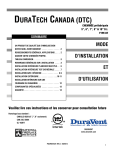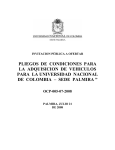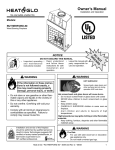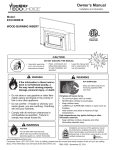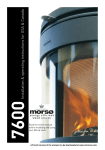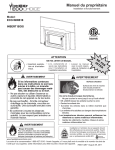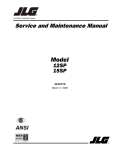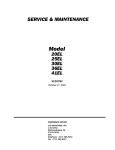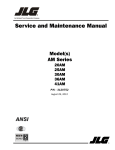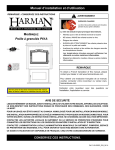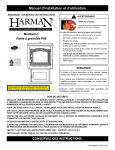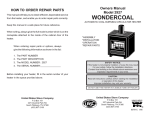Download DuraVent 6DP-VC Installation Guide
Transcript
All-Fuel Chimney System ® DuraPlus Installation Instructions A MAJOR CAUSE OF VENT RELATED FIRES IS FAILURE TO MAINTAIN REQUIRED CLEARANCES (AIR SPACES) TO COMBUSTIBLE MATERIALS. IT IS OF THE UTMOST IMPORTANCE THAT DURAPLUS CHIMNEY BE INSTALLED ONLY IN ACCORDANCE WITH THESE INSTRUCTIONS. NOTE: Read through all of these instructions before beginning your installation. Failure to install as described in this instruction will void the manufacturer’s warranty, and may have an effect on your homeowner’s insurance and UL listing status. Keep these instructions for future reference. This booklet also contains instructions for installing a venting system within an existing masonry chimney, and for installations passing through a cathedral ceiling. Dear Customer, Installer, or End User: We welcome any comments regarding matters pertaining to our DuraVent products. We welcome any ideas, input or complaints and I’ll make sure that someone responds directly back to you. Send your emails to: [email protected] If you are searching for tech support or product information, please phone us at 800-835-4429. Or email us at: [email protected] C A ME R A -R E A DY L OG OT Y P E – UL MA R K F OR C A NA DA A ND T HE U.S . T hese Marks are registered by Underwriters L aboratories Inc. LISTED MH7399 For the most up-to-date installation instructions, see www.duravent.com CONTENTS DuraPlus All-fuel Chimney System Clearance / Permits / Applications / Notes. . . . . . . . . . . . . . . . . . . . . . . . . . . 4 Chimney Diameter / Chimney Height / Chimney Placement . . . . . . . . . . . . . 5 Chimney Enclosure Requirements / Stove Recommendations. . . . . . . . . . .6 Step-by-Step Directions / Ceiling Supported . . . . . . . . . . . . . . . . . . . . . . . . 7 Offset Elbow Installation. . . . . . . . . . . . . . . . . . . . . . . . . . . . . . . . . . . . . . . . . 12 Offset Chart . . . . . . . . . . . . . . . . . . . . . . . . . . . . . . . . . . . . . . . . . . . . . . . . . . . .13 Extended Roof Bracket Installation. . . . . . . . . . . . . . . . . . . . . . . . . . . . . . . . 14 Roof Supported Installations. . . . . . . . . . . . . . . . . . . . . . . . . . . . . . . . . . . . . 15 Tee Supported Installations . . . . . . . . . . . . . . . . . . . . . . . . . . . . . . . . . . . . . 16 Masonry Fireplace Installations . . . . . . . . . . . . . . . . . . . . . . . . . . . . . . . . . . 18 Zero Clearance Fireplace Installations. . . . . . . . . . . . . . . . . . . . . . . .21 Connection from Appliance to Chimney System . . . . . . . . . . . . . . . . . . . 21 ® Chimney Maintenance. . . . . . . . . . . . . . . . . . . . . . . . . . . . . .. . . . . . . . . . . . . 22 3 CLEARANCE Allow at least a 2-inch clearance between DuraPlus Pipe and any combustible materials. Where the chimney passes through floors, joists, or ceilings, Firestop Radiation Shields, Support Boxes, and Close Clearance Shields may permit reduced clearances as established by these parts, or spacers built on to these parts. The clearance (air space) between the outer chimney wall, and the inside of the Support Box, Firestop Radiation Shields, and Close Clearance Shields, in the cases of 7 and 8-inch diameter chimney will be less than 2 inches. Both of these systems have been extensively tested and evaluated at these clearances. This reduced clearance is permissible at these internal locations only. All other areas require a 2-inch minimum clearance. Never fill any required clearance space with insulation or any other materials. Combustible materials include lumber plywood, sheetrock, plaster and lath, furniture, curtains, electrical wiring and building insulation. Keep single wall stovepipe at least 18 inches away from combustible materials, unless a clearance reduction system that is acceptable to the authority having jurisdiction is used, or the appliance to be installed is listed and the instructions specify a different clearance. PERMITS Contact your local Building Official or Fire Official regarding permits, restrictions, and installation inspections in your area. DuraPlus APPLICATIONS Use DuraPlus with wood stoves, fireplaces, furnaces, boilers, water heaters, stoves, ranges, or other residential-type appliances fueled by oil, gas, coal, or wood. Do not use 4 with forced draft positive-pressure appliances. DuraPlus systems are designed to extend vertically with a maximum of (2) offsets of 30° (offset and return). DuraPlus is tested to UL Test Proceedure 103HT, and listed under UL Re-examination Service Number MH7399. Tools You May Need Hammer Level Caulking Gun Plumb Bob Screwdriver Tin Snips Saber or Keyhole Saw Drill Materials You May Need Non-hardening Waterproof Sealant 8 Penny Nails 5/16 inch x 3 inch long Lag Screws Roofing Nails 3/4 inch Galvanized Electrical Conduit (where the chimney extends 4 feet or more above the roof) Safety Equipment Dependable Ladder Eye Protection Proper Gloves and Shoes INSTALLATION NOTES Proper planning for your DuraPlus installation will result in greater safety, efficiency, and convenience, as well as saving time and money. Use only authorized DuraPlus (SDP) listed chimney parts. You must use 100% DuraPlus listed parts to obtain a DuraPlus listed system. Do not mix parts or try to match with other products, or use improvised solutions. Do not install damaged parts. Table 1 lists the authorized components, and their respective Underwriter’s Laboratory Catalog Table 1 duraplus (sdp) parts with ul catalog numbers UL Cat # Part UL Cat # Part SDP-P Chimney Sections SDP-TS Tee Support Bracket SDP-T Tee SDP-IS Insulation Shield SDP-F Flashing SDP-FRS Firestop Radiation Shield SDP-TF Flat Roof Flashing SDP-SC Storm Collar SDP-S Flat Ceiling Support Box SDP-WS Wall Strap SDP-RS Round Ceiling Support Box SDP-ES Elbow Strap SDP-SB Square Ceiling Support Box SDP-RSA Extended Roof Bracket SDP-WT Wall Thimble SDP-AP SDP-C Chimney Cap Anchor Plate Numbers. The UL Catalog Numbers will be referred to within the instructions, as an aid to assembly, however for ordering, use the stock numbers shown in the Chimney Products Catalog. Practice good workmanship. Sloppy work could jeopardize your chimney’s safety. Keep electrical wiring and insulation away from all chimneys and stovepipes. DuraPlus may be installed up to 35 feet high. If a chimney is installed higher than 35 feet, a supporting Elbow Strap must be placed every 8 feet. If the chimney extends more than 4 feet above the roof, an Extended Roof Bracket must be used. Subtract 1-1/2 inches from each Chimney Section’s length to calculate installed length. CHIMNEY DIAMETER CHIMNEY PLACEMENT Follow the appliance manufacturer’s instructions to determine chimney diameter and clearances between combustible materials and your heating appliance. Never choose a chimney with an inside diameter smaller than the appliance flue gas outlet. To calculate the chimney’s outside diameter, add 4 inches to the inside diameter. CHIMNEY HEIGHT The National Fire Protection Association Standard #211 states: “Chimneys shall extend at least three feet above the highest point where it passes through the roof of a building, and at least two feet higher than any portion of a building within ten feet.” (Figure 1). When deciding the location of your chimney, try to minimize the alteration and reframing of structural components of the building. 2 feet min. above highest point of roof within 10 feet 3 feet min. from roof penetration 10 Feet minimum chimney height Figure 1 5 Attic Attic insulation shield Ceiling Firestop radiation shield enclosure must have 2 inches clearance between chimney and wall. floor support box Figure 2 CHIMNEY ENCLOSURE REQUIREMENTS Through Rooms: Interior chimneys shall be enclosed where they extend through closets, storage areas, or habitable spaces where the surface of the chimney could be contacted by persons or combustible materials. The space between the chimney and the enclosure shall be at least 2 inches. (Figure 2). Multi-Story: The National Fire Protection Association Standard #211 states: “ Factorybuilt chimneys that pass through floors of buildings requiring the protection of vertical openings shall be enclosed with approved walls having a fire reistance rating of not less than one hour when such chimneys are located in a building less than 4 stories in height, and not less than 2 hours when such 6 chimneys are located in a building more than 4 stories in height.” Cold Climates: In cold climates, chimneys mounted on an outside wall should be enclosed. Exterior chases reduce condensation and creosote formation, and enhance draft. Include an access door by the Tee Cleanout Cap for chimney cleaning. See figure 23. STOVE RECOMMENDATIONS Follow the stove manufacturer’s instructions. The requirements stated below pertain to all stoves or other appliances installed with DuraPlus chimney systems. Choice: Choose a stove that is listed by a recognized testing laboratory, is appropriate for your needs, and is not larger than required. Installation: Once the chimney system is in place, install the stove and stovepipe as described in the stove manufacturer’s instructions, maintaining all required clearances. Flues: Connect only one solid fuel appliance per chimney. Oil-burning appliances are restricted to one appliance per chimney, as well. Operation: Follow the stove manufacturer’s instructions and safety manual for maximum efficiency and safety. Overfiring can damage the stove and stovepipe. Fuels: Do not burn driftwood, plastic, or chemically treated wood such as railroad ties. They are corrosive to your fireplace, stovepipe and chimney. Follow the stove manufacturer’s instructions and safety manual in regards to fuels. Not all stoves are equipped to burn coal. Coal with a low sulfur content will reduce the possibility of corrosion. Mobile Homes: Please read the stove manufacturer’s instructions and safety manual carefully. Not all stoves are listed for use in mobile homes. STEP-BY-STEP DIRECTIONS There are five general types of DuraPlus installations: 1. Ceiling-supported 2. Roof-supported 3. Tee-supported (through the wall) 4. Masonry Fireplace 5. Zero-Clearance Fireplace Review the step-by-step directions before beginning your installation. Attic minimum of 2 inches below finished ceiling 18 inches minimum for single-wall stovepipe CEILING SUPPORTED 1. Place Appliance: Position the appliance according to the manufacturer’s instructions. The flue outlet collar should be placed between the rafters or joists above, if possible. 2. Frame Support Opening: Drop a plumb bob to the center of the appliance’s flue outlet and mark this center point on the ceiling. Refer to Table 2 for specific framing and clearance dimensions. Mark appropriate cutting lines around the center point. Cut a square hole in the ceiling for a Square Support Box, or a round hole for a Round Support Box. Frame a level, square opening centered over the hole which you have cut. (Figures 3 and 4). cap sdp-c flashing ventilated sdp-sc storm collar sdp-sc chimney sections sdp-p 14 1/2” attic insulation shield sdp-is ceiling joists 14 1/2” framing support box joists 2 inches minimum below finished ceiling framed opening square ceiling support box sdp-sb OR round ceiling support sdp-rs Figure 3 Figure 4 7 cap sdp-c storm collar sdp-sc flashing ventilated sdp-sc chimney sections sdp-p round ceiling support sdp-rs attic insulation shield sdp-is Firestop Radiation shield sdp-is flat support box sdp-s attic second story Figure 5 support box in cathedral ceiling with trim frame in place wood screw (6 req) round ceiling support with trim plates in place wood screw (8 req) Figure 6 3. Install Support: Slip the Support Box ,(Figure 5), into the framed opening. It must extend at least 2 inches below the finished ceiling. Level the Square Support Box and nail it to the framing using at least two 8-penny nails per side. The two Trim Frames are positioned as shown, and screwed through the ceiling and into the framing members with (6) 1-1/4 inch long round-head wood screws. (Figure 6). The bottom of the Round Support must also be at least 2 inches below the finished ceiling. Trim for the Support Boxes is “U-shaped” . The trim pieces are adjusted to accommodate the Square Support Box, and screwed into the framing, using wood screws. A completed Square Support Box installed in 8 2 inch min clearance inside of enclosure chimney sections sdp-p framed enclosure min of 2 inches below finished ceiling square ceiling support box sdp-sb OR round ceiling support sdp-rs Figure 7 framed opening a cathedral ceiling with the “U-shaped” trim is also shown in Figure 6. Trim kits are available in brass, to enhance the appearance of the various Support Boxes and Trim Frames . Where the chimney passes through additional floors and ceilings, install Firestop Radiation Shields. Where the chimney passes through an attic, Firestop Radiation Shields and Insulation Shields must be installed. 4. Frame Openings: Frame openings in each ceiling or floor above the Support Box. (Figure 7). These openings are to hold the Firestop Radiation Shields and Attic Insulation Shields. Locate each opening by dropping a plumb bob to the four corners of the opening below. Maintain the minimum clearances and Table 2 framing for square support boxes, round support boxes and wall thimbles SQUARE SUPPORT BOXES Chimney inside diameter 6 INCHES 7 INCHES 8 INCHES Framed opening inside dimensions 14 ½ x 14 ½ 14 ½ x 14 ½ 14 ½ x 14 ½ Chimney inside diameter 6 INCHES 7 INCHES 8 INCHES Framed opening inside dimensions 14 ½ x 14 ½ 14 ½ x 14 ½ 14 ½ x 14 ½ Chimney inside diameter 6 INCHES 7 INCHES 8 INCHES Framed opening inside dimensions 14 ½ x 14 ½ 14 ½ x 14 ½ 14 ½ x 14 ½ Chimney inside diameter 6 INCHES 7 INCHES 8 INCHES Framed opening inside dimensions 14 ½ x 14 ½ 14 ½ x 14 ½ 14 ½ x 14 ½ ROUND SUPPORT BOXES WALL THIMBLES FIRESTOP RADIATION SHIELD dimensions as specified in Table 2. If Elbows must be used to avoid an obstruction, refer to the offset elbow installation section. 5. Cut Roof Opening: Cut an opening in the roof directly above the opening below, and at least 4 inches larger than the chimney’s outside diameter to provide at least a 2-inch clearance all around the chimney. If the installation is located between rafters that are 16 inches on center, Close Clearance Shields (a sheet metal product fabricated by DuraVent), may be used to avoid structural reframing. (Figure 8). The 2-inch minimum clearance to combustibles is not required when the chimney passes through Close Clearance Shields. When using Close Clearance Shields, Ventilated Flashing must be installed. Refer to Figure 10, which pictures both Ventilated and Non-ventilated Flashing. 6. Install Firestop Radiation Shield: One of two possible situations exist for installing the Firestop Radiation Shield. One is a two- story dwelling where the chimney passes 14 inches roof 14 inches 14 inches pitch line x x cut panel’s to roof pitch line Figure 8 through a Firestop Radiation Shield, a ceiling, and into an attic. The other is a multi-story building where the chimney passes through a Firestop Radiation Shield, through a ceiling, into another story, and then into an attic. Each of these require a different configuration of the Firestop Radiation Shield. Figure 7 9 firestop radiation shield sdp-frs nails (at least 2 per side) two-story going into attic framing framing firestop radiation shield sdp-frs multi-story going into next floor Figure 9 nails (at least 2 per side) ventilated flashing Figure 10 Chimney section sdp-p support box sdp-s, sdp-rs, sdp-sb Figure 11 10 illustrates the two-story building. In the case of the two-story installation, the base of the Firestop Radiation Shield is nailed to the top of the framing, with the pan (the depressed portion of the base), facing downwards. For the multi-story installation, the base is nailed to the bottom of the framing with the pan facing upwards. The cylindrical component of the Firestop Radiation Shield is then slipped down through the base from the top until it rest on the bead. (Figure 9). Refer to Table 2 for the framing requirements. 7. Assemble Chimney Sections: Lower and seat the female end of the first Chimney Section in the Support Box. (Figure 11). It will twist-lock onto the male end of a Low Profile Starter Section, which is a component of the Support Box. Turn Pipe Sections clockwise, firmly to lock them together. Sheet metal screws may be used to reinforce the connection, however they are not normally required. Screws are only acceptable in the outer liner. 8. Install Attic Insulation Shield: Install the Attic Insulation Shield where the chimney passes into an attic. It’s purpose is to prevent debris and insulation from getting too close to the chimney. (Figure 12). An installed Attic Insulation Shield is 14 inches high. In attic areas where this shield won’t fit, a Square Support Box, (which is available in heights up to 36 inches), can be used instead of an Attic Insulation Shield, provided it reaches through the roof; refer to the Roof Supported Installation section on page 14. If the chimney is fully enclosed through the attic, an Insulation Shield is not required, however, again, Ventilated Flashing must be used. Where the chimney passes into the attic, install the Attic Insulation Shield as follows: a. If the Firestop Radiation Shield extends above the attic floor, no modifications are necessary. The Firestop Radiation Shield will fit inside the Attic Insulation Shield. b. Assemble Chimney Sections until at least 18 inches of chimney extends above the Firestop Radiation Shield. c. Slip the Insulation Shield over the Chimney and Firestop Radiation Shield until the base sits squarely on the framed opening. (Figure 7). d. Nail the Insulation Shield to the top of the framed opening with at least two 8-penny nails per side. (Figure 12). e. Wrap the Collar around the chimney and fasten it loosely. Slide the Collar down to meet the Insulation Shield. Slip the tab through the adjacent slot and fold it back to tighten the Collar. (Figure 13). 9. Attach Flashing: In new construction, assemble the Chimney Sections to a point above the roof, then slip the Flashing over the chimney. On an existing roof, center and install the Flashing before extending the chimney above the roof. Allow space to permit sliding the next Chimney Section up through the Flashing. Always insure the chimney remains vertical, and that at least a 2-inch clearance to combustible materials is maintained all around. Install the upper edge of the Flashing under the roofing. Nail to the roof along the upper edge and the upper half on each side with 1-inch roofing nails. Do not nail the lower edge of the Flashing, or the lower half of the sides. (Figure 14). Seal all nail heads with a non-hardening waterproof sealant. On flat or tarred and graveled roofs, nail and seal the Flat Roof Flashing to the roof on all sides with roofing compound. Do not put screws through the Flashing into the Chimney Pipe. 10. Finish Top: Apply a non-hardening waterproof sealant around the chimney at the point where the Storm Collar will meet the warning: if chimney is enclosed in attic area, you must use ventilated flashing. sdp-is Figure 12 Figure 13 push collar down to flashing and seal with non-hardening sealant. (sealant shown in heavy line) 1 inch roofing nails along top of flashing storm collar sdp-sc flashing sdp-f sdp-tf Figure 14 11 cap sdp-c apply small bead of non-hardening sealant along seam seam of chimney pipe section Figure 15 splitter splitter top view Figure 16 sdp-es sdp-e 15º / 30º sdp-p not more than 48 inches rise sdp-p offset Figure 17 12 chimney above the Flashing, and also along the vertical seam of the chimney pipe, which is exposed to the weather. (Figures 14 and 15). Slide the Storm Collar down over the chimney to the top of the Flashing. Tighten and seal the Storm Collar against the sealant. After installing sufficient Chimney Sections to meet the height requirement, (Figure 1), snap the Chimney Cap onto the top of the chimney. The Chimney Cap can be removed for chimney cleaning as described in the Chimney Maintenance section of the instructions. Use an Extended Roof Bracket if the chimney extends more than 4 feet above the roof. (Figures 18, and 19) in the Extended Roof Bracket section. If you are located in heavy snow country, a “splitter” should be fabricated from heavy gauge sheet metal, and installed. (Figure 16). This will route the snow around the chimney, and protect it. This item is not furnished by DuraVent. 11. Enclosures: Enclose chimneys where they pass through occupied spaces, including closets. Always maintain at least a 2 inch clearance between the chimney and any combustible surface. Interior enclosures may be constructed with standard framing and sheathed with sheetrock or plywood. Use Wall Straps, if necessary, to maintain a minimum of 2 inches of air space between the chimney and combustible materials. OFFSET ELBOW INSTALLATION Elbows are manufactured in 15° and 30° angles measured from the vertical. A 30° Elbow is the largest that can be used in an offset. A 30° Elbow may not be combined with a 15° Elbow to make a 45° offset for example. Avoid Elbows if possible, since a totally vertical chimney is more efficient. When Elbows are necessary to avoid obstructions such as rafters, ridgepoles, or joists, use no more than 2 pairs of Elbows (4 elbows total) in any one chimney system. 1. Attach Elbows: Attach Elbows to Chimney Sections or other Elbows by twisting clockwise until they lock firmly. Attach one Elbow to the Chimney Section below, and align it for the offset. If the needed direction of the Elbow is different than the fully locked position, the Elbow can be rotated to desired direction and can be secured to pipe section with a minimum of (4) sheet metal screws. Do not penetrate the inner wall. Refer to Table 3 to determine the required offset length and attach an appropriate length (or lengths) of Chimney Section(s) above the Elbow. Do not exceed the maximum lengths between the Elbows specified in Table 3. Attach the second Elbow above the Chimney Section to complete the offset. (Figure 17). 2. Secure Offset: Place the Elbow Strap’s band around the angled portion of the top Elbow, then tighten the nut and bolt until the clamp is firm. Wrap the Elbow Strap end over an adjacent joist or rafter and secure it with at least two 8-penny nails. Do not add more Chimney Sections until the Elbows are supported. Be sure that the chimney remains vertical. If the total length of the Chimney Sections between the two Elbows exceeds 3 feet, install a second Elbow Strap around the center of the Chimney Section(s). Table 3 duraplus (sdp) OFFSET CHART SIZE Elbow Chimney Degrees Section 6” DIAMETER Offset Rise Inches Inches 7” DIAMETER Offset Rise Inches Inches 8” DIAMETER Offset Rise Inches Inches 15° 0” 1 1⁄2” 12” 1 3⁄4” 13 1⁄2” 1 3⁄4” 13 1⁄2” 15° 12” 4 1⁄4” 23 ½” 4 1⁄4” 20 1⁄2” 4 1⁄4” 23 1⁄2” 15° 24” 7 1⁄2” 10 1⁄2” 13 1⁄4” 3 3⁄4” 9” 15” 21” 26 1⁄4” 34” 45 1⁄2” 55 1⁄2” 14 3⁄4” 24” 33 3⁄4” 44” 53” 7 3⁄4” 10 3⁄4” 13 1⁄2” 3 3⁄4” 9” 15” 21” 26” 35 1⁄2” 46 3⁄4” 57” 14 1⁄4” 24” 33 1⁄4” 43 1⁄2” 52 1⁄2” 6 3⁄4” 9 1⁄2” 12” 3 3⁄4” 9” 14 3⁄4” 20 1⁄2” 25 1⁄2” 35 1⁄2” 47” 57 1⁄4” 14 3⁄4” 24” 34 1⁄4” 44 3⁄4” 53 3⁄4” 15° 36” 15° 24”+24” 30° 0” 30° 12” 30° 24” 30° 36” 30° 24”+24” RISE OFFSET 13 chimney section sdp-p extended roof bracket sdp-rsa 60º 3/4 inch thin-wall galvanized electrical conduit (not furnished) Figure 18 chimney cap sdp-c (Figures 18 and 19). Cut 2 pieces of 3/4 inch thin wall galvanized steel electrical conduit, (or rigid galvanized tubing) to these lengths. The conduit is not furnished by DuraVent, and must be locally procured. Mount the two Roof Brackets where the conduit meets the roof, using 6 roofing nails per bracket. Seal the nail heads carefully with a non-hardening, waterproof sealant. 3. Attach Conduit: Flatten 1 inch and drill a 1/4-inch hole at each end of both pieces of conduit. Bolt each conduit to the Pipe Band and Roof Brackets with the nuts and bolts provided. extended roof bracket sdp-rsa A 60º storm collar sdp-sc Note: if dimension ‘a’ is greater than 4-feet, extended foof bracket must be used. a minimum of 2 inches below finished ceiling 18 inches minimum for single-wall stovepipe flashing sdp-F, Sdp-tf consists of: (1) pipe band, (2) roof bracket connected with 3/4 inch thin-wall galvanized electrical conduit. (not furnished by Simpson Dura-Vent). Flatten ends and bolt to pipe band and bracket. Figure 19 cap sdp-c storm collar sdp-sc ventilated flashing sdp-f chimney sections sdp-p EXTENDED ROOF BRACKET INSTALLATION If the chimney extends more than 4 feet above the roofline, an Extended Roof Bracket must be installed at every 4-foot increment of height above the roofline, leaving no more than 4 feet extending above the last pipe band. 1. Mount Pipe Band: Slip the Pipe Band around the chimney and secure by tightening the nut and bolt. 2. Install Roof Brackets: Measure from the Pipe Band to the points where the conduit will meet the roof, and form approximately a 60° angle with the chimney, and with each other. 14 roof framed opening square ceiling support box sdp-sb push support box up through roof, trim and fold back excess as shown in fig. 22 Figure 20 ROOF SUPPORTED INSTALLATIONS Use only where a leveled Square Support Box will extend at least 2 inches below the ceiling (on the low side), while the top edge at least covers the edge of the roof’s decking material. Square Support Boxes are available in 11 inch, 24 inch, and 36 inch heights. Mobile home chimney installations are roof supported, and use Ventilated Flashings. Do not seal openings. 2 inches minimum 18 inches minimum for single-wall stovepipe cap sdp-c ventilated flashing sdp-f storm collar sdp-sc 1. Place Appliance: Place the appliance in it’s proper location, referring to the manufacturer’s instructions as to allowable distances from combustibles, etc. 2. Cut Openings: Cut a roof opening directly above the appliances’ flue outlet collar, just as in a Ceiling-Supported Installation (Steps 1 thru 5). If a separate ceiling and roof exists, as shown in Figure 20, (Low Attic), first cut and frame a ceiling opening as described in Ceiling-Supported Installations (Step 2). Refer to Table 2 for clearance and framing specifications. If it is desired to install through a cathedral ceiling (Figure 21), then the hole is cut in the roof. 3. Install Support Box: Slip the Square Support Box into the framed opening so it projects at least 2 inches below the finished ceiling and rafters, and extends above the ceiling to framing or decking materials to which it will be nailed. Level the Support Box, and slit the corners to the roofline where they extend beyond it. Bend the flaps (created by the slitting) flush with the roof, and nail the Support Box to the roof or framing with at least two 8-penny nails per side. (Figure 22). Screw the trim sections into the ceiling. (Figure 6). chimney sections sdp-p support box sdp-sb square ceiling support box sdp-sb push support box up through roof, trim and fold back excess as shown in fig. 22 Figure 21 Figure 22 15 4. Complete Installation: Refer to Steps 8, and 9, in the Ceiling Supported Installation section, to complete the Roof-Supported installation. pipe sdp-p pipe section 6-inch or 9-inch sdp-p tee sdp-t wall thimble sdp-wt TEE-SUPPORTED INSTALLATIONS Tee-Supported installations are used when passing through a wall to an outside chimney. The required parts and general configuration are as shown in Figures 23, and 24. 1. Place Appliance: Position the appliance according to the manufacturer’s instructions. 2. Cut and Frame Opening: Cut 14-1/4 inch diameter holes in the inner and outer walls. The center of these holes should be aligned with the center of the stove’s flue outlet collar. For new construction, prior to sheetrock or other covering of the wall studs is applied, frame a square opening between the studs, as specified in Table 2. ( Figure 25). Should it be necessary to go through concrete, masonry, or cinder-block, a 14-1/4 inch 5/16 x 3” lag screws (6 req) not furnished removable tray (component of sdp-ts) tee cap component of sdp-t tee cap (component of sdp-t) tee support sdp-ts Figure 24 14 1/2” allow 1/2 inch air space between base of flashing or cover and enclosure framing. warning: Ventilated flashing must be used with enclosures. framed exterior enclosure typical thru-the-wall tee- supported installation 14 1/2” access door for cleaning Figure 25 Figure 23 16 diameter hole must be cut through the wall. 3. Install Wall Thimble: Insert the black section of the Wall Thimble into the opening in the wall from inside the room, and align the nail holes with the studs. (Figure 26). Do not nail the black thimble section at this time. Attach the Tee to a 9-inch or 12-inch Chimney Section by twisting until it is firmly locked. If the wall is less than 6 inches thick, use a 9-inch Chimney Section; if the wall is between 6 and 9 inches thick, use a 12-inch Chimney Section. From outside the building, insert the Chimney Section into the hole until the vertical part of the Tee is 2 inches away from the outside of the wall, and the black portion of the Wall Thimble and the Chimney Section protrude into the room at least 2 inches. IMPORTANT: In order to make a safe connection, the female end of the Chimney Section must fully contact the inside face of the Wall Thimble. Remove the 5/16 x 3” lag screws (6 req) not furnished 8-penny nails (4) req shims to maintain circularity of thimble (2) req (not furnished, may be made of wood) Tee and Chimney Section from the wall, and nail the Wall Thimble’s black section to the studs with four 1-inch roofing nails. If the Wall Thimble is going through a concrete wall, and no framing members are available to which to nail the black portion of the Wall Thimble to, use masonry anchors to attach it. If a TeeSupported installation is being installed in a garage, it must be enclosed. (Figure 27). 4. Seal Outside: From the outside, insert the galvanized section of the Wall Thimble through the wall and into the black section. If it does not reach the black section, an extension tube can be locally made from .018” thick galvanized steel. Seal the flange of the galvanized portion of the Wall Thimble to the outside wall, using non-hardening waterproof sealant, and fasten it to the wall with screws. From the outside, slip the Chimney Section, which is attached to the Tee, into the Thimble. NEVER INSTALL SINGLE WALL STOVEPIPE THROUGH THE WALL THIMBLE! 5. Install Tee Support: Remove the two screws from the Tee Cleanout Cap, and detach it from the Tee. Attach the Tee Support Straps to the base with the nuts and bolts provided. 14 1/2” note: if system exits thru wall into garage, an enclosure isrequired. 14 1/2” view from outside ventilated flashing must be used 2 inches minimum Dura plus chimney pipe 2 inches minimum outside 2 inches minimum enclosure interior portion of wall thimble sdp-wt (black) 2 inches minimum clearance Figure 26 access door for cleaning tee sdp-t GARAGE Figure 27 17 wall strap allow a minimum of 2 inches air space on all sides 2 inches minimum 2 inches minimum Figure 28 Use (2) 5/16 inch, 3-inch long lag screws to attach the straps to the wall. Replace the Tee Cleanout Cap and screws, once the Tee is installed. 6. Complete Chimney: Attach the Chimney Sections as in Step 7 of the Ceiling Supported Installation section. Secure the chimney to the wall with Wall Straps at 4-foot intervals to maintain at least 2 inches of clearance to combustible materials. Slip the Wall Straps around the chimney, tighten the bolts, and fasten the Wall Straps to the wall with (2) 5/16-inch, 3-inch long lag screws. Snap the Chimney Cap into the top of the chimney, once it is at the height specified in Figure 1. If the chimney penetrates an overhang, frame for at least 2 inches of clearance, and install 18 a Flashing and Storm Collar as described in Steps 8, 9 and 10 for Ceiling Supported Installations. Another option is to cut away the overhang for a 2-inch clearance. (Figure 28). If the chimney extends more than 4 feet above the top Wall Band, or Flashing, use an Extended Roof. 7. Install Chase Cover. If a chase enclosure has been constructed, installing the chase cover requires some special considerations. The chase must be ventilated at the top and a 1/2-inch air gap must be established between the cover, and the framed chase top. In addition, a 1/2-inch air gap should exist between the hole in the cover, and the Chimney Pipe Sections. Figure 29 displays in some detail, how these air gaps are established with locally fabricated spacers and covers. These are not furnished by DuraVent, but may be made from 28 gage or heavier sheet metal. Should the installer elect to use Flat Roof Flashing, (which is a stock item), the air spaces are still required. When installing the Storm Collar, do not push it down all the way to the cover, but allow an air space for flow between the Chimney Pipe and the hole in the cover. MASONRY FIREPLACE INSTALLATIONS 1. Determine Chimney Size: Use Table 4 to determine the correct diameter chimney for your fireplace. 2. Mount Anchor Plate: Chimneys for masonry fireplaces begin with an Anchor Plate. Center the Anchor Plate on a brick or concrete base over the masonry flue opening. Seal the Anchor Plate with a high-temperature sealant, and secure with (4) 1/4-inch masonry anchors. (Figure 30). Be sure it is level. The Anchor Plate is available in two styles. One contains the perforated Starter Section, which is used 1/2 inch air space established by spacers 1/2 inch air space flat roof flashing 12 inch minimum framed chase enclosure in the event the chimney is to be enclosed. The other is a flat plate, to be used in cases when the chimney is not enclosed. 3. Attach Chimney: Place the first Chimney Section over the flange on the Anchor Plate with the arrows pointing up. Drill 1/8-inch diameter holes through the outer sleeve of the Chimney Section which match the location of the corresponding holes in the Anchor Plate. Secure the Chimney Section to the Anchor Plate with #8 self-tapping sheet metal screws. 4. Finish Chimney: Install the rest as directed in the Ceiling Supported Installation section, Steps 4 through 10. Refer to Figure 1 and Table 4 for chimney height requirements. Always maintain at least 2 inches of clearance to combustible materials, and enclose the chimney where it passes through occupied areas. Use a Wall Strap for every four feet of chimney height. nail (as req) cap sdp-c storm collar (sdp-sc) chimney pipe section sdp-p flat roof flashing (sdp-tf) must be ventilated spacers locally frabricated (not furnished by simpson dura-vent) chimney sections sdp-p 1/2 low-profile starter section (required if chimney is enclosed) anchor plate sdp-ap masonry anchors (4) req (not furnished) sheet metal screws (4) req existing masonry chimney hi-temp sealant Figure 29 Figure 30 19 Table 4 20 chimney section sheet metal screws base plate (sdp-bp) zero-clearance fireplace Figure 31 ZERO-CLEARANCE FIREPLACE INSTALLATIONS 1. Manufacturer’s Instructions: Carefully read and comply with the manufacturer’s installation instructions for your fireplace. Verify that DuraVent’s DuraPlus chimney is approved for use on your fireplace. 2. Base Plate: Attach a Base Plate to the fireplace top with sheet metal screws. (Figure 31). A high temperature sealant may be used if desired. 3. Chimney Sections: Attach a Chimney Section to the Base Plate by twist-locking. 4. Completion: Install the remainder as instructed for a standard Ceiling-Supported installation, (less the Support Box). Always maintain at least 2 inches of clearance to combustibles, and enclose the chimney where it passes through occupied areas. CONNECTION FROM APPLIANCE TO CHIMNEY SYSTEM 1. Single Wall Stovepipe: DuraVent’s “DuraBlack” stovepipe is recommended, if single wall stovepipe is desired. The connection to the ceiling support box, or wall thimble is made with a DuraBlack Slip Connector (Part# 1670, 1770, or 1870, for 6-inch, 7-inch, or 8-inch pipe, respectively). The beaded end of the slip connector slips into the hole in the ceiling support or wall thimble. Align the tabs on the slip connector with the notches in the face of the support or wall thimble, push the connector in, and twist to lock it in. Further instructions for assembling the DuraBlack pipe are contained in their shipping cartons. Remember, the minimum clearance to combustibles for single wall stovepipe is 18 inches. 2. DVL: DuraVent manufactures DVL, which is a double-wall connector pipe, which may be positioned within 6 inches to a combustible wall, and within 8 inches to a combustible ceiling, provided the appliance installation instructions permit this distance. In order to join this type of connector to the ceiling support, or wall thimble, a Close Clearance Adaptor (Part #8674, 8774, or 8874, for 6-inch, 7-inch, or 8-inch pipe, respectively), is required. The adaptor slips into the hole in the ceiling support, or wall thimble. Align the tabs on the adaptor with the slots cut into the face of the ceiling support, or wall thimble, push in, and twist to lock it in place. Detailed instructions for assembling the remainder of the close clearance system are included in the shipping cartons. 21 CHIMNEY MAINTENANCE 1. Creosote and Soot: When wood is burned slowly, it produces tar and other organic vapors, which combine with expelled moisture to produce creosote. The creosote vapors condense in the relatively cool chimney flue of a slow-burning fire. As a result, creosote residue accumulates on the flue lining. When ignited, this creosote makes an extremely hot fire. 2. Access. Chimneys must be installed so that access is provided for inspection and cleaning. 3. When to Clean: The chimney should be inspected at least once every month during the heating season to determine if creosote or soot has built up. Check spark arrestor screens every 2 to 4 weeks. If creosote or soot has accumulated, it should be removed to reduce the risk of chimney fire. 4. How to Clean: Have your chimney cleaned by a certified professional chimney sweep if you have doubts about your ability to clean it. Use a plastic, wood, or steel brush. Do not use a brush that will scratch the stainless steel liner of your chimney. Scrub the spark arrestor with a wire brush. To remove the Chimney Cap for cleaning, unscrew the four screws that attach the cap’s support legs to the cap base. The Tee Cleanout Cap can be removed once the screws are unscrewed. Remember to replace the cap when you are finished cleaning the chimney. 5. Coal: To reduce corrosion in chimneys where coal is burned, clean the chimney thoroughly within 48 hours of shutting down the stove for the season. 6. Chemical Cleaners: Use chemical cleaners only as a last resort, and use only those which the manufacturer specifically warrants as being non-corrosive to the chimney liner. DuraVent will assume no 22 liability for damage resulting from the use of chemical cleaners. 7. In Case of Fire: If a flue fire occurs, close all appliance draft openings, and call your Fire Department. Do not use the chimney again, until it has been inspected for possible damage. 8. Painting: To increase chimney life, coat all exterior metal parts, with the exception of the Chimney Cap with high temperature, rust proof paint. Wash the metal with a vinegar and water solution before painting. 9. Creosote Formation: DuraVent assumes no liability for structural damage or roof contamination as the result of creosote formation. It is the owner’s responsibility to comply with inspection and cleaning requirements as described in these instructions. 23 M&G DuraVent limited lifetime Warranty M&G DuraVent, Inc. (“DuraVent”) provides this limited lifetime warranty for all of its products with the exception of Ventinox® (lifetime), and PolyPro® (ten years). Subject to the limitations set forth below, DuraVent warrants that its products will be free from defects in material or manufacturing, if properly installed, maintained and used. DuraVent products are fully warranted if installed only by a professional installer. This Warranty is transferable from the original homeowner to the buyer of the home. This warranty does not cover normal wear and tear, smoke damage or damage caused by chimney fires, acts of God, or any product that was: (1) purchased other than from an authorized DuraVent dealer, retailer or distributor; (2) modified or altered; (3) improperly serviced, inspected or cleaned; or (4) subject to negligence or any use not in accordance with the installation instructions included with the product as determined by DuraVent. Installation instructions are available online at www.duravent.com under Support/Literature and through our Customer Service Department 800-835-4429 or [email protected]. This limited lifetime warranty applies only to parts manufactured by DuraVent. DuraVent provides the following warranties for its products: One Hundred Percent (100%) MSRP 15 years from the date of purchase, and Fifty Percent (50%) thereafter, except for the following limitations on: all Termination Caps and DuraBlack® are warranted at One Hundred Percent (100%) for five years. All warranty obligations of DuraVent shall be limited to repair or replacement of the defective product pursuant to the terms and conditions applicable to each product line. These remedies shall constitute DuraVent’s sole obligation and sole remedy under this warranty. This warranty provides no cash surrender value. The terms and conditions of this warranty may not be modified, altered or waived by any action, inaction or representation, whether oral or in writing, except upon the express, written authority of an executive officer of DuraVent. Corn, bio-fuels, driftwood or other wood containing salt, preservative-treated lumber, plastic and household trash or garbage, or wood pellets containing such materials must not be burned in the appliance or fireplace. In case of a chimney fire, the chimney must be inspected and approved by a certified Chimney Sweep before reuse. After each annual inspection, maintenance, and cleaning, the certified Chimney Sweep must fill out and date the appropriate section of the warranty card provided with the chimney liner. LIMITATIONS ON INTERNET SALES: Notwithstanding any other terms or conditions of this Limited Lifetime Warranty, DuraVent provides no warranty for the following specific products if such products are not installed by a qualified professional installer: DuraTech®, DuraPlus HTC®, DuraChimney® II, PelletVent Pro®, DirectVent Pro®, FasNSeal®, FasNSeal® W2, FasNSeal® Flex, and PolyPro®, and M&G DuraVent’s relining products including DuraLiner®, DuraFlex® (SW, Pro, 316, 304), and Ventinox®. For purposes of this warranty, a trained professional installer is defined as one of the following: licensed contractors with prior chimney installation experience, CSIA Certified Chimney Sweeps, NFI Certified Specialists, or WETT Certified Professionals. DuraVent must be notified and given the opportunity to inspect defective product prior to replacement under the terms of this limited lifetime warranty. All warranty claims must be submitted with proof of purchase. Labor and installation costs are not covered under this warranty. To obtain warranty service contact: DuraVent Warranty Service, 877 Cotting Ct., Vacaville CA 95688, or call 800-835-4429. WHERE LAWFUL, DURAVENT DISCLAIMS ALL OTHER WARRANTIES, INCLUDING BUT NOT LIMITED TO IMPLIED WARRANTIES OF MERCHANTABILITY AND FITNESS FOR A PARTICULAR PURPOSE. IN NO EVENT WILL DURAVENT BE LIABLE FOR INCIDENTAL, CONSEQUENTIAL, PUNITIVE OR SPECIAL DAMAGES OR DIRECT OR INDIRECT LOSS OF ANY KIND, INCLUDING BUT NOT LIMITED TO PROPERTY DAMAGE AND PERSONAL INJURY. DURAVENT’S ENTIRE LIABILITY IS LIMITED TO THE PURCHASE PRICE OF THIS PRODUCT. SOME STATES DO NOT ALLOW LIMITATIONS ON IMPLIED WARRANTIES, OR THE EXCLUSION OR LIMITATION OF INCIDENTAL OR CONSEQUENTIAL DAMAGES, SO THE ABOVE LIMITATIONS AND EXCLUSIONS MAY NOT APPLY TO YOU. THIS LIMITED WARRANTY GIVES YOU SPECIFIC LEGAL RIGHTS, AND YOU MAY ALSO HAVE OTHER RIGHTS THAT VARY FROM STATE TO STATE. For the most up-to-date installation instructions, see www. duravent.com REV 3.22.2012 Manufactured in Vacaville CA and Albany NY Customer Service Support 800-835-4429 707-446-4740 FAX www.duravent.com DuraPlus is a registered trademark of the M&G DuraVent, Inc. All rights reserved. Made in the USA. M&G DuraVent is a member of M&G Group. ©2012 L119 04/2012

























